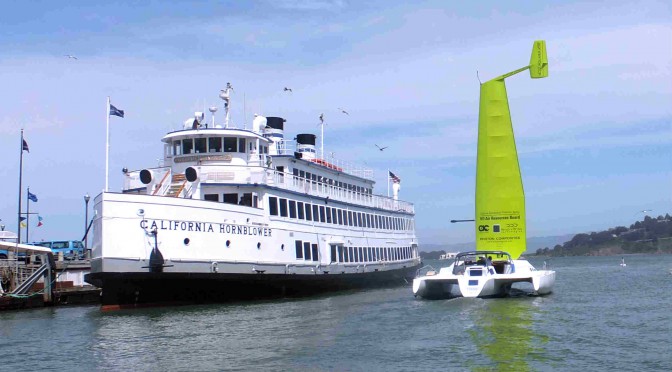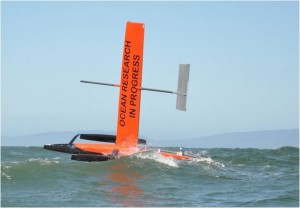It seems like the technology of sailing continues to evolve at a faster rate. From Kimball Livingston’s Blue Planet Times.

By Kimball Livingston Posted April 21, 2014
Eventually, someone is going to get “wind assisted” transport right.
Don’t bet against Richard Jenkins.
The same Richard Jenkins who spent his first ten adult years figuring out how to set a wing-powered landsailing speed record of 126.2 mph.
The same Richard Jenkins who recently, remotely, sailed a 19-foot, wing-and-solar-powered prototype drone from San Francisco Bay to Kaneohe Bay, Oahu, then to the South Pacific, and back, and who is now neck deep in developing his next generation Saildrone, capable of carrying a complete array of oceanographic research instrumentation to any coordinates on the blue reaches of the Blue Planet. Never putting humans in harm’s way. With none of the fuel burn or
accumulated costs of, say, a 200-foot diesel-powered research vessel. And there just might be a circumnavigation . . .
 And— all of this is tied together by the control mechanism that Jenkins developed when he realized that his landsailer was hitting speeds too fast to be controlled by pulling on stuff, the way people sail a boat. Even a “stable” breeze had too much fluctuation for human response. But, a tiny trim tab, trailing behind the wing, set to maintain a constant angle of attack, could turn the trick.
And— all of this is tied together by the control mechanism that Jenkins developed when he realized that his landsailer was hitting speeds too fast to be controlled by pulling on stuff, the way people sail a boat. Even a “stable” breeze had too much fluctuation for human response. But, a tiny trim tab, trailing behind the wing, set to maintain a constant angle of attack, could turn the trick.
Jenkins projects an impish enthusiasm, an infectious enthusiasm and a raw, boyish enthusiasm from beneath a halo of curly hair that shifts in the breeze. He sails. He flies. He innovates. He hits his marks. It’s easy to understand how, given the success of the prototype Saildrone, Google’s executive chairman, Eric Schmidt, would say yes to a proposal to fund a fleet. With his wife, Wendy, Schmidt funds the 11th Hour Project, putting juice into many environmental, climate, and oceans-related undertakings. But for Jenkins, it’s been a long road to get to this point. He will tell you, when he was building his fourth record-hunting landsailer, which turned out to be the right one, “I had no idea there was any practical application. I spent years thinking I would eventually take the speed record, and beyond that, what I had on my hands was a totally useless technology. It’s funny how one thing leads to another.”
Or he might quip about how he has turned an engineering career into an adventure in “double-down or quits.” Jenkins was a student in England, earning some money on the side at Green Marine, when he inquired about a curious contraption abandoned in a dark corner. It was, he was told, one of those record-hunter dreams, never finished, and in a flash he said something like, “Can I have it?”
So innocently did this begin.